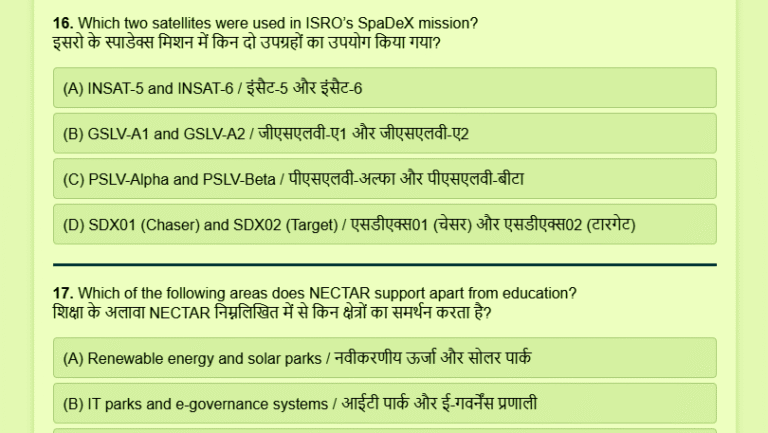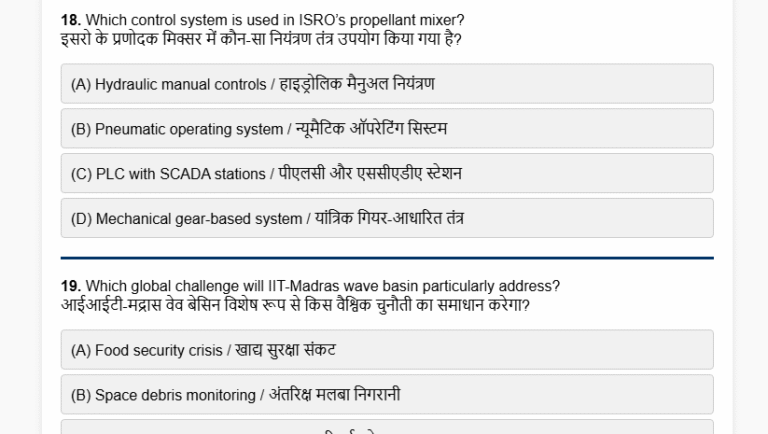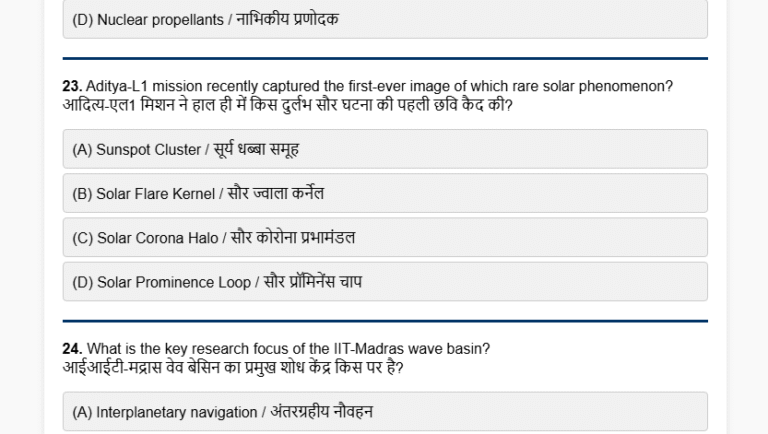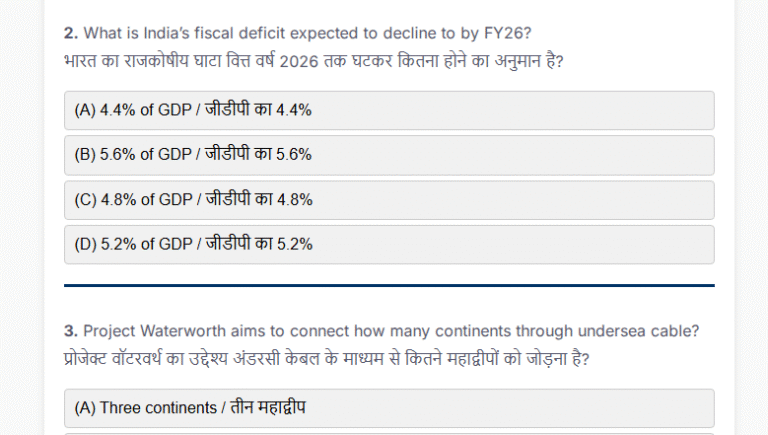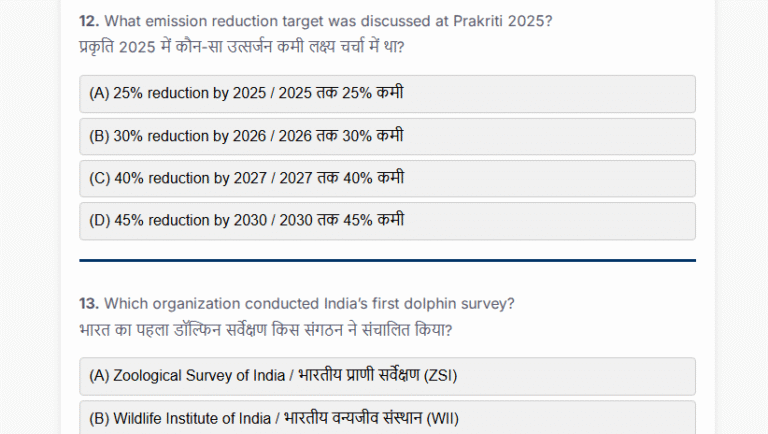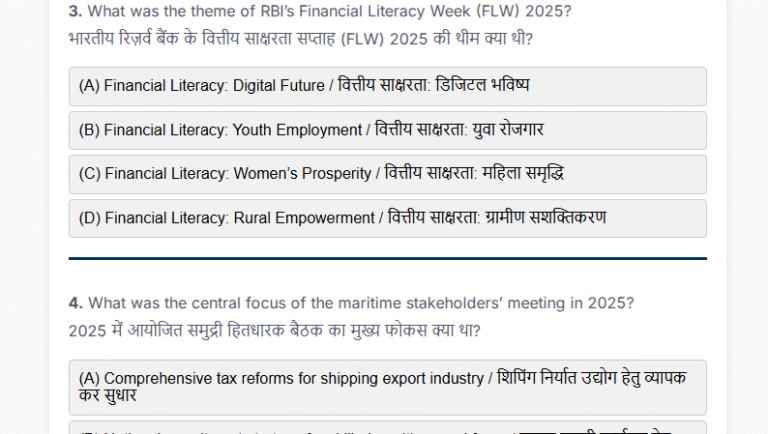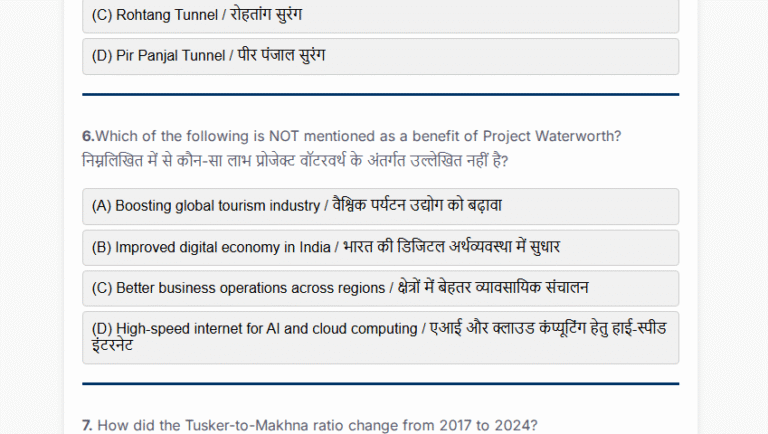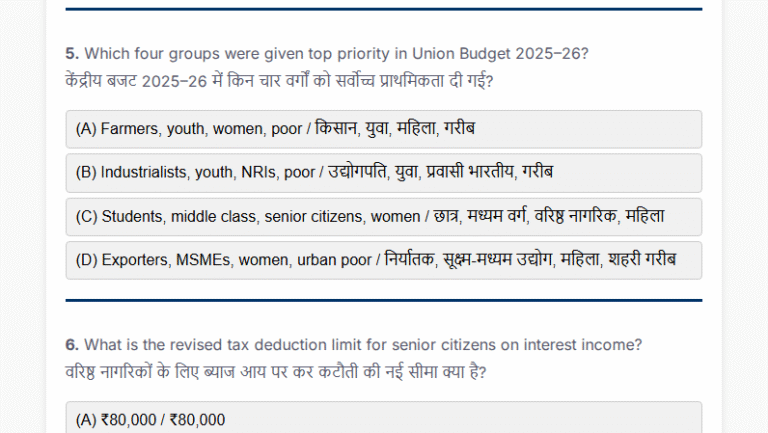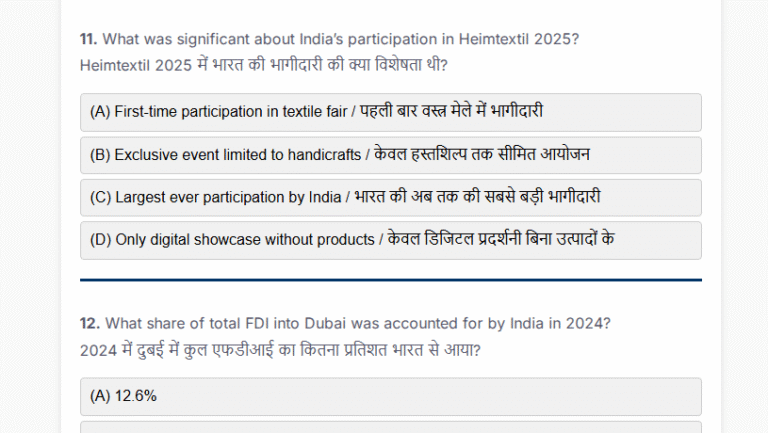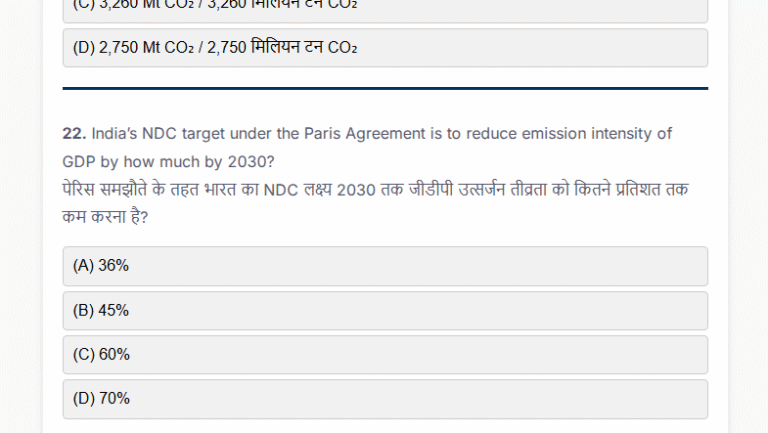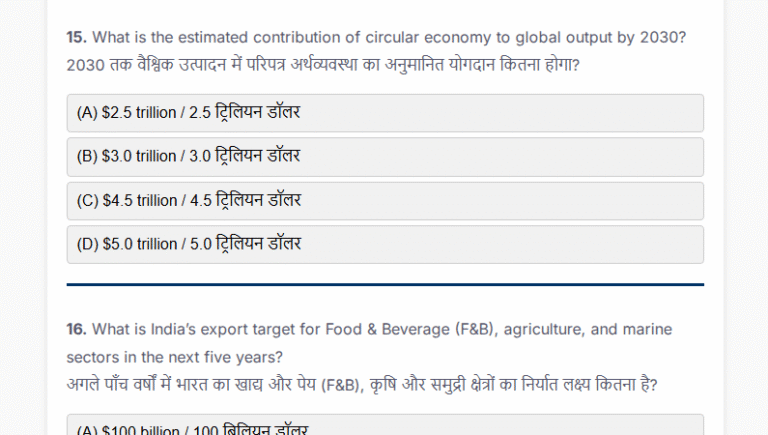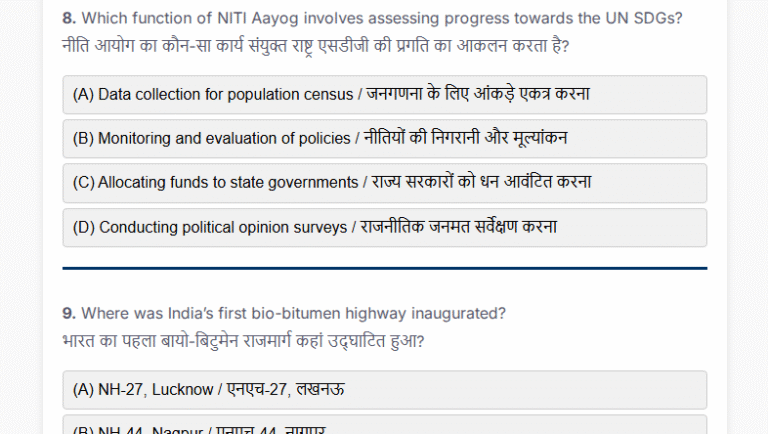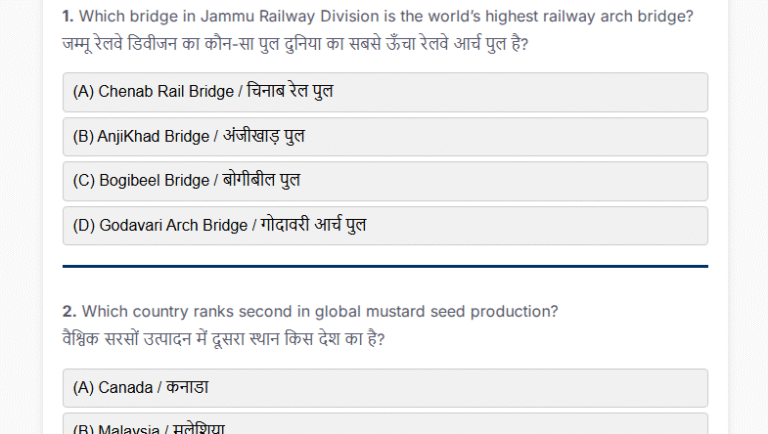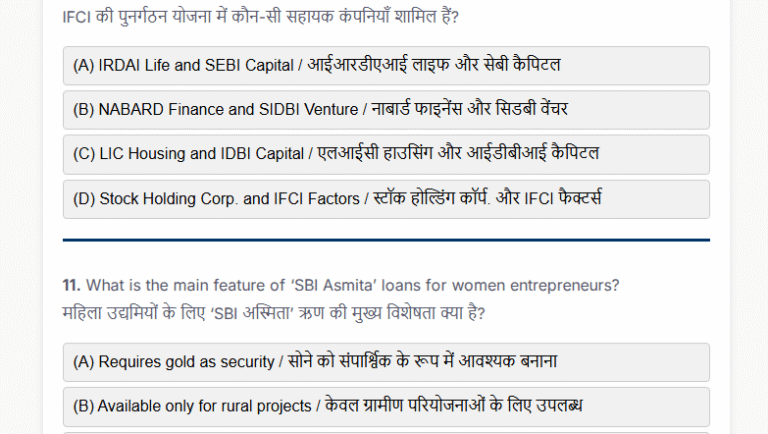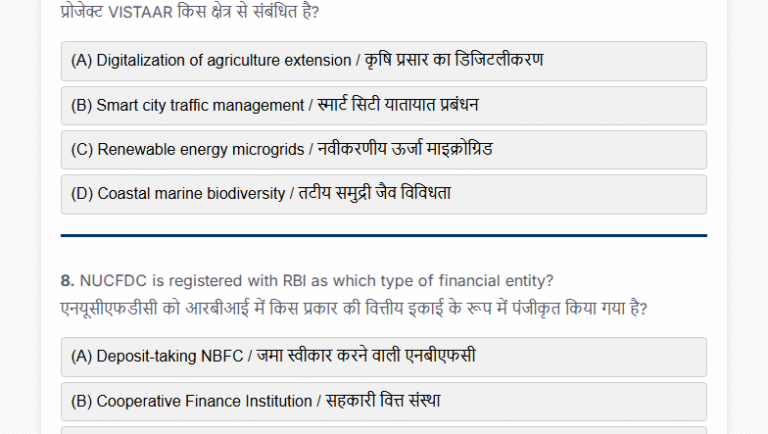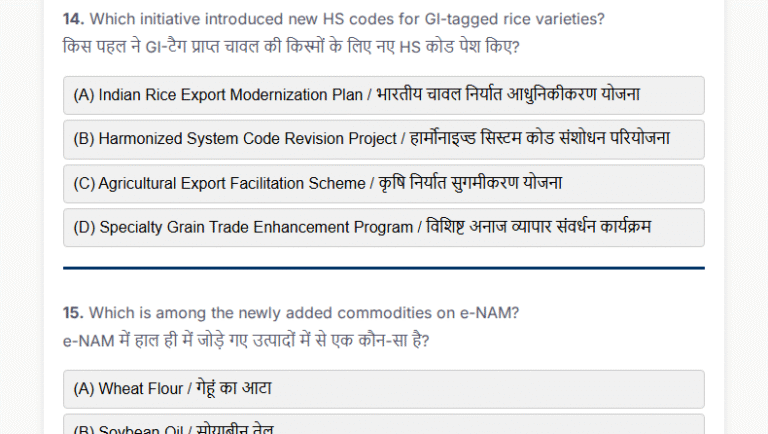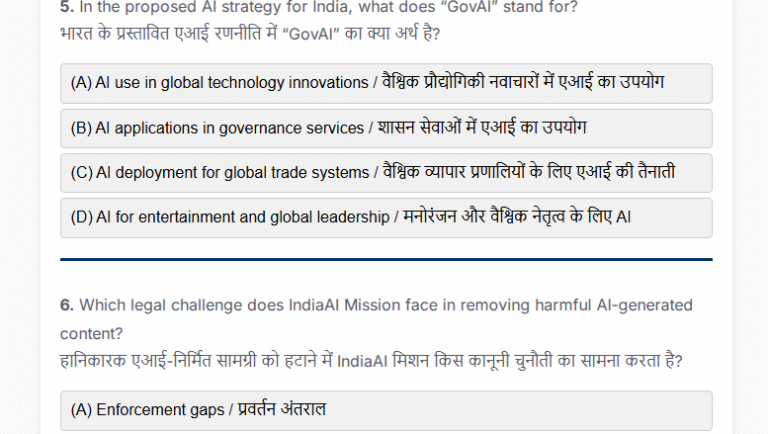Current Affairs Today MCQs (7 Nov 2024)
1. According to a recent UN report, how many people in the Horn of Africa are currently food insecure?
(A) 45 million
(B) 55 million
(C) 65 million
(D) 75 million
The correct answer is (C) 65 million
A recent UN report reveals that over 65 million people in the Horn of Africa are food insecure. The region is highly affected by food shortages due to its arid climate, frequent droughts, and political instability, which have intensified food insecurity. The Horn of Africa includes countries such as Ethiopia, Eritrea, Djibouti, and Somalia. Broader definitions of the region sometimes include parts or all of Kenya, Sudan, and Uganda. This region’s ongoing humanitarian crises underscore the urgency for international support and assistance.
2. Which of the following countries are part of the Horn of Africa, according to the narrow geographical definition?
(A) Ethiopia, Eritrea, Djibouti, Somalia
(B) Kenya, Sudan, Uganda, Somalia
(C) Ethiopia, Kenya, Uganda, Djibouti
(D) Somalia, Kenya, Sudan, Eritrea
The correct answer is (A) Ethiopia, Eritrea, Djibouti, Somalia
The Horn of Africa, in its narrow geographical definition, consists of Ethiopia, Eritrea, Djibouti, and Somalia. This region is located in the horn-shaped part of northeastern Africa and is known for its arid climate and geopolitical importance. Broader definitions of the Horn of Africa sometimes include Kenya, Sudan, and Uganda, given their proximity and shared environmental and socio-economic challenges. Due to its strategic location along the Red Sea and Gulf of Aden, the Horn of Africa holds significant geopolitical importance.
3. What makes the Horn of Africa a UNESCO Biodiversity Hotspot?
(A) Its dense forest cover and diverse wildlife
(B) The presence of unique flora and fauna adapted to its arid climate
(C) Its proximity to the Equator
(D) Large population of migratory bird species
The correct answer is (B) The presence of unique flora and fauna adapted to its arid climate
The Horn of Africa is recognized as a UNESCO Biodiversity Hotspot due to its unique flora and fauna adapted to the arid environment. Despite its harsh climate, the region supports diverse ecosystems, including endemic species found nowhere else in the world. The Horn’s biodiversity is threatened by climate change, deforestation, and human activities, which have put its ecosystems under pressure. UNESCO’s designation as a biodiversity hotspot highlights the region’s ecological importance and the need for conservation efforts to protect these unique habitats.
4. Which body of water borders the Horn of Africa to the south?
(A) Red Sea
(B) Mediterranean Sea
(C) Guardafui Channel
(D) Persian Gulf
The correct answer is (C) Guardafui Channel
The Horn of Africa is bordered by the Guardafui Channel to the south, which connects it to the Indian Ocean. This geographic location, along with its proximity to the Red Sea and the Gulf of Aden, gives the Horn of Africa strategic importance in maritime trade routes, particularly those connecting Asia, Africa, and Europe. The region’s location is of interest to both regional and global powers, who seek influence over these critical waterways.
5. The Thadou community in India is primarily located in which state?
(A) Assam
(B) Manipur
(C) Nagaland
(D) Mizoram
The correct answer is (B) Manipur
The Thadou community is one of the oldest and largest non-Naga tribes in Manipur, India. Historically, they have practiced animistic rituals, although Christianity now plays a significant role in their lives. The Thadou language is part of the Tibeto-Burman language family and exhibits dialectal variations. The Thadous celebrate the Hun-Thadou Cultural Festival, showcasing their rich cultural heritage. Recently, the Thadou community extended support to the BJP-led state government’s initiative to implement the National Register of Citizens (NRC) in Manipur.
6. CARICOM was established to promote which of the following objectives?
(A) Military cooperation in the Caribbean region
(B) Economic integration and coordination of foreign policy
(C) Cultural exchange between Caribbean and African nations
(D) Environmental protection in the Caribbean islands
The correct answer is (B) Economic integration and coordination of foreign policy
CARICOM, or the Caribbean Community, was established in 1973 with the signing of the Treaty of Chaguaramas. It aims to promote economic integration, cooperation, and foreign policy coordination among its member states. CARICOM’s 15 member countries and 5 associate members, primarily located in the Caribbean, work together on trade, security, and sustainable development. The organization’s secretariat is in Georgetown, Guyana, underscoring its commitment to unifying the region economically and politically.
7. Where is the CARICOM Secretariat headquartered?
(A) Kingston, Jamaica
(B) Port of Spain, Trinidad and Tobago
(C) Georgetown, Guyana
(D) To study marine ecosystems
The correct answer is (C) Georgetown, Guyana
The CARICOM Secretariat is headquartered in Georgetown, Guyana. Established in 1973, CARICOM is a regional organization focused on promoting economic integration, cooperation, and coordination of foreign policy among Caribbean member states. The Secretariat serves as the administrative body of CARICOM, working to implement the organization’s policies and objectives. The choice of Georgetown reflects CARICOM’s commitment to regional unity and support for the development of member states.
8. Which of the following is not a member of CARICOM?
(A) Jamaica
(B) Trinidad and Tobago
(C) Bahamas
(D) Guatemala
The correct answer is (D) Guatemala
The Caribbean Community and Common Market (CARICOM) is a political and economic union that aims to promote economic integration and cooperation among its members. The organization was established in 1973 by the Treaty of Chaguaramas, signed by Barbados, Jamaica, Guyana, and Trinidad and Tobago.
It has 15 member states and 5 associate members:
Member states
(1) Antigua and Barbuda,
(2) Bahamas,
(3) Barbados,
(4) Belize,
(5) Dominica,
(6) Grenada,
(7) Guyana,
(8) Haiti,
(9) Jamaica,
(10) Montserrat,
(11) St. Lucia,
(12) St. Kitts and Nevis,
(13) St. Vincent and the Grenadines,
(14) Suriname, and
(15) Trinidad and Tobago
Associate members
(1) British Virgin Islands,
(2) Turks and Caicos,
(3) Anguilla,
(4) Cayman Islands, and
(5) Bermuda
Significant benefits of being a member of CARICOM include:
– A single market for many member states
– Passport holders can travel to other CARICOM states without a visa.

9. Which country in the Horn of Africa is known as part of the Somali Peninsula?
(A) Eritrea
(B) Ethiopia
(C) Djibouti
(D) Somalia
The correct answer is (D) Somalia
Part of the Horn of Africa is referred to as the Somali Peninsula, which mainly includes Somalia and parts of eastern Ethiopia. The peninsula is known for its historical and cultural ties to the Somali people and their unique socio-cultural identity in the region. Located in northeastern Africa, the Somali Peninsula extends into the Gulf of Aden and Indian Ocean, making it an area of significant geopolitical interest. Somalia’s location also contributes to the Horn’s strategic importance in international trade.
10. Which language family does the Thadou language belong to?
(A) Indo-European
(B) Dravidian
(C) Austroasiatic
(D) Tibeto-Burman
The correct answer is (D) Tibeto-Burman
The Thadou language belongs to the Tibeto-Burman language family and has multiple dialectal variations. This language family is common among several ethnic groups in northeastern India, including the Thadous, who are one of the largest non-Naga tribes in Manipur. The Thadou community has a rich cultural heritage, with traditional religious practices that have since evolved with the influence of Christianity. This connection to the Tibeto-Burman family reflects the Thadous’ historical ties to other groups in the Himalayan and northeastern Indian regions.
11. If India wins its bid to host the 2036 Olympics, it would become the ___ Asian country to host the event.
(A) 2nd
(B) 3rd
(C) 4th
(D) 5th
The correct answer is (C) 4th
If India is chosen to host the 2036 Olympics, it would become the 4th Asian country to host the event, following China, South Korea, and Japan. Hosting the Olympics would be a significant milestone for India, showcasing its infrastructure and organizational capabilities on a global stage. India faces competition from countries like Saudi Arabia, Indonesia, Chile, Qatar, and Turkey, which are also vying for the opportunity. The decision regarding the host country will be made after the International Olympic Committee’s (IOC) elections next year, adding anticipation to India’s historic bid.
12. Which of the following sports are likely to be included in India’s bid for the 2036 Olympics?
(A) Cricket and badminton
(B) Kabaddi, kho-kho, and chess
(C) Tennis, swimming, and golf
(D) Football and volleyball
The correct answer is (B) Kabaddi, kho-kho, and chess
India’s bid for the 2036 Olympics may feature traditional Indian sports like kabaddi, kho-kho, and chess. Including these sports aligns with India’s cultural heritage and aims to promote its unique athletic traditions on the global stage. Yoga is also considered, representing India’s contribution to holistic well-being. If successful, India’s Olympics would offer a diverse sporting lineup, celebrating both international and indigenous sports. This approach could boost India’s soft power and international image, enhancing the cultural experience for athletes and spectators worldwide.
13. The Olympic Games are held every four years. Which of the following pairs will host the Games in 2028 and 2032, respectively?
(A) Paris and Tokyo
(B) Los Angeles and Brisbane
(C) Tokyo and Los Angeles
(D) Paris and Brisbane
The correct answer is (B) Los Angeles and Brisbane
Los Angeles is set to host the 2028 Olympic Games, while Brisbane has been selected for the 2032 Games. The Olympics are organized every four years, with host cities chosen through a bidding process that considers factors like infrastructure, security, and economic stability. Hosting the Games brings significant global attention and economic opportunities to the cities, while also posing logistical and financial challenges. The selection of Los Angeles and Brisbane reflects the IOC’s confidence in their capabilities to host such a large-scale international event.
14. Which of the following statements is true regarding the Olympic Rings?
(A) They represent the continents where the Games originated.
(B) They symbolize the unity of continents through sport.
(C) Each ring represents a different Olympic sport
(D) They are only used during the Summer Olympics.
The correct answer is (B) They symbolize the unity of continents through sport.
The five interlocking Olympic Rings represent the unity of the world’s continents—Africa, the Americas, Asia, Europe, and Oceania—through sport. Designed by Pierre de Coubertin, the founder of the modern Olympics, the rings signify global harmony and solidarity in athletic competition. The rings appear in the official emblem of the Games, representing inclusiveness and peace. Along with the Olympic Flame, which is lit in Olympia and carried to the host city, the rings are an iconic symbol of the Games’ spirit of unity and excellence.
15. What is the primary goal of the TULIP (Traditional Artisans’ Upliftment Livelihood Programme) initiative in India?
(A) To fund skill development centers for artisans
(B) To provide an e-platform for marginalized artisans to market their products
(C) To promote art education in rural schools
(D) To offer financial assistance to unemployed youth
The correct answer is (B) To provide an e-platform for marginalized artisans to market their products
TULIP, launched by India’s Ministry of Social Justice and Empowerment, aims to empower marginalized artisans, particularly from Scheduled Castes (SC), Other Backward Classes (OBC), sanitation workers, and persons with disabilities. Through an e-platform, TULIP enables these artisans to market their products on a global scale, helping them gain exposure and increase sales. This initiative seeks to provide these communities with economic opportunities, enhancing their livelihoods and promoting India’s rich artisanal heritage. TULIP aligns with government efforts to support marginalized groups through inclusive and sustainable development.
16. Which organization recently signed a $200 million loan agreement with India for the Uttarakhand Livability Improvement Project?
(A) World Bank
(B) International Monetary Fund (IMF)
(C) Asian Development Bank (ADB)
(D) New Development Bank (NDB)
The correct answer is (C) Asian Development Bank (ADB)
The Asian Development Bank (ADB) signed a $200 million loan agreement with India for the Uttarakhand Livability Improvement Project. This project aims to enhance infrastructure in cities like Haldwani, Champawat, and Kichha by upgrading roads, traffic management, flood controls, and water supply systems. ADB, founded in 1966 and headquartered in Manila, Philippines, focuses on fostering social and economic development across Asia and the Pacific. This partnership highlights ADB’s role in supporting sustainable urban infrastructure development in Indian states, particularly in ecologically sensitive regions like Uttarakhand.
17. In which city is the headquarters of the Asian Development Bank (ADB) located?
(A) Tokyo, Japan
(B) Beijing, China
(C) Manila, Philippines
(D) Jakarta, Indonesia
The correct answer is (C) Manila, Philippines
The headquarters of the Asian Development Bank (ADB) is at 6 ADB Avenue, Mandaluyong, Metro Manila, Philippines. Established in 1966, ADB’s mission is to promote social and economic development across Asia and the Pacific through financial assistance, including loans, grants, and technical support. The institution’s largest shareholders are Japan and the United States, each holding a 15.6% stake. ADB has 68 member countries, with India being a founding member. The bank plays a critical role in funding developmental projects in the Asia-Pacific region, enhancing infrastructure, health, and economic resilience.
18. Which countries are the largest shareholders in the Asian Development Bank (ADB) as of 2023?
(A) India and China
(B) Japan and the USA
(C) Australia and New Zealand
(D) Russia and Japan
The correct answer is (B) Japan and the USA
Japan and the USA are the largest shareholders in the Asian Development Bank (ADB), each holding a 15.6% share as of 2023. These countries have significant influence over ADB’s strategic and operational directions. ADB, headquartered in Manila, provides financial assistance to support development in its member countries, particularly in Asia and the Pacific. This partnership emphasizes the vital roles Japan and the USA play in promoting social and economic development across the region through loans, technical assistance, and grants.
19. Which of the following Indian cities is NOT part of the Uttarakhand Livability Improvement Project?
(A) Haldwani
(B) Champawat
(C) Kotdwar
(D) Dehradun
The correct answer is (D) Dehradun
The Uttarakhand Livability Improvement Project focuses on enhancing infrastructure in Haldwani, Champawat, Kichha, Kotdwar, and Vikasnagar. Dehradun is not part of this project. Supported by a $200 million loan from the Asian Development Bank (ADB), the project will upgrade roads, traffic management, flood prevention, and water systems in these cities. The initiative aims to improve living conditions and strengthen urban infrastructure, particularly in Uttarakhand’s smaller cities, fostering sustainable urban development in this ecologically sensitive region.
20. What does the Olympic motto “Citius, Altius, Fortius” mean in English?
(A) Fast, Strong, and United
(B) Stronger Together
(C) Faster, Higher, Stronger
(D) Unity in Strength
The correct answer is (C) Faster, Higher, Stronger
The Olympic motto, “Citius, Altius, Fortius,” translates from Latin to “Faster, Higher, Stronger.” This phrase encapsulates the spirit of the Olympic Games, urging athletes to push their physical and mental limits in pursuit of excellence. Originating in ancient Greece, the modern Olympics were revived in 1896 in Athens and have since been held every four years, alternating between the Summer and Winter Games. The motto, along with symbols like the Olympic Rings and Flame, represents the values of sportsmanship, unity, and peace on the global stage.
Set 20 Quarterly CA 2025 Jan to March IMPORTANT INSTRUCTIONS This test consists of 25 questions.At…
Set 19 Quarterly CA 2025 Jan to March IMPORTANT INSTRUCTIONS This test consists of 25 questions.At…
Set 18 Quarterly CA 2025 Jan to March IMPORTANT INSTRUCTIONS This test consists of 25 questions.At…
Set 17 Quarterly CA 2025 Jan to March IMPORTANT INSTRUCTIONS This test consists of 25 questions.At…
Set 16 Quarterly CA 2025 Jan to March IMPORTANT INSTRUCTIONS This test consists of 25 questions.At…
Set 15 Quarterly CA 2025 Jan to March IMPORTANT INSTRUCTIONS This test consists of 25 questions.At…
Set 14 Quarterly CA 2025 Jan to March IMPORTANT INSTRUCTIONS This test consists of 25 questions.At…
Set 13 Quarterly CA 2025 Jan to March IMPORTANT INSTRUCTIONS This test consists of 25 questions.At…
Set 12 Quarterly CA 2025 Jan to March IMPORTANT INSTRUCTIONS This test consists of 25 questions.At…
Set 11 Quarterly CA 2025 Jan to March IMPORTANT INSTRUCTIONS This test consists of 25 questions.At…
Set 10 Quarterly CA 2025 Jan to March IMPORTANT INSTRUCTIONS This test consists of 25 questions.At…
Set 9 Quarterly CA 2025 Jan to March IMPORTANT INSTRUCTIONS This test consists of 25 questions.At…
Set 8 Quarterly CA 2025 Jan to March IMPORTANT INSTRUCTIONS This test consists of 25 questions.At…
Set 7 Quarterly CA 2025 Jan to March IMPORTANT INSTRUCTIONS This test consists of 25 questions.At…
Set 6 Quarterly CA 2025 Jan to March IMPORTANT INSTRUCTIONS This test consists of 25 questions.At…
Set 5 Quarterly CA 2025 Jan to March IMPORTANT INSTRUCTIONS This test consists of 25 questions.At…
Set 4 Quarterly CA 2025 Jan to March IMPORTANT INSTRUCTIONS This test consists of 25 questions.At…
Set 2 Quarterly CA 2025 Jan to March IMPORTANT INSTRUCTIONS This test consists of 25 questions.At…
Set 3 Quarterly CA 2025 Jan to March IMPORTANT INSTRUCTIONS This test consists of 25 questions.At…
Test Series of 1st Quarterly Current Affairs 2025 प्रथम त्रैमासिक करेंट अफेयर्स 2025 की टेस्ट सीरीज़…
Current Affairs Today MCQs (26 Nov 2024) 1. What is the primary purpose of the Rejang Dewa dance in…
Current Affairs Today MCQs (25 Nov 2024) 1. What feature distinguishes African penguins from other…
Current Affairs Today MCQs (24 Nov 2024) 1. Which of the following is a distinctive feature of…
Current Affairs Today MCQs (23 Nov 2024) 1. What is the target adaptation finance commitment for the…
Current Affairs Today MCQs (22 Nov 2024) 1. How many youth are targeted for internships under the PM…
Current Affairs Today MCQs (21 Nov 2024) 1. Which is the funding ratio for PM-JAY between the Centre…
Current Affairs Today MCQs (20 Nov 2024) 1. Who is eligible for the Ayushman Vay Vandana Card? (A)…
Current Affairs Today MCQs (5 Nov 2024) 1. What conditions contribute to the formation of the DANA…
Current Affairs Today MCQs (4 Nov 2024) 1. What is the primary function of Israel’s Iron Beam…
Current Affairs Today MCQs (3 Nov 2024) 1. To whom was the Balfour Declaration addressed? (A) David…



